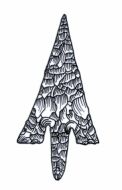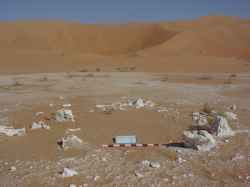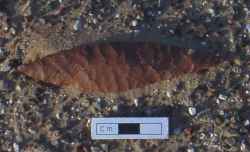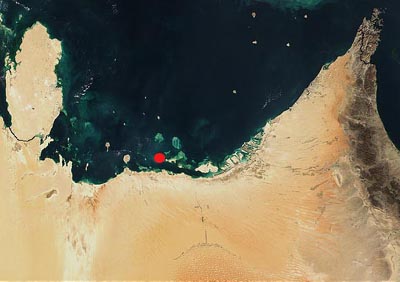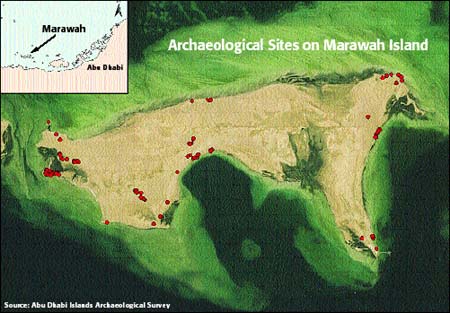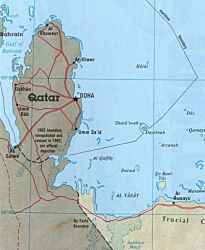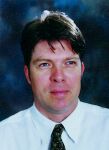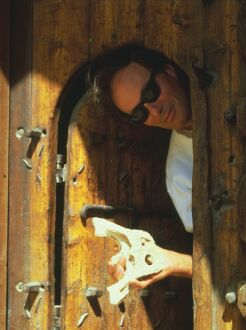The ADIAS
Occasional Newsletter is edited by Peter
Hellyer & Dr. Mark Beech. Neolithic
settlements discovered in SE desert of Abu Dhabi
Neolithic
settlements discovered in SE desert of Abu Dhabi The discovery was made by
an ADIAS team working in collaboration
with the Department of Antiquities
and Tourism, Al Ain. Dr Mark Beech (ADIAS Senior Resident Archaeologist),
Dr Heiko Kallweit (ADIAS researcher) and Dr Walid Yasin Al-Tikriti (Archaeology
Adviser, Department of Antiquities and Tourism) carried out fieldwork
in the Umm az-Zumul region between January 24th to February 6th 2004. Mapping was undertaken of
a total of 80 sites where there were significant clusters of worked
flint and other stone material. In the KHM region these lithic scatters
were spread almost continuously along the northern edge of the plain
for more than 3km! One area of particular interest that requires further detailed investigation was identified in the Kharimat Khor Al Manahil area (sites KHM2-4). This was a large oval depression ca 120 x 50 metres in size. Nearly all of the flints noted here were collected from the terraced edge around this depression. It is tempting to speculate that the depression itself may originally have been a small water pool or lake around 6-7000 years ago, when the climate was significantly wetter than it is today. This, however, requires further geomorphological work and testing of sediment samples in the future. The most exciting result of the recent work was the discovery of two major settlement areas with surviving stone structures. No pottery was found at any of these sites but there were large quantities of Late Stone Age flints scattered amongst and around the sites. A group of three adjacent stone structures was located in the Kharimat Khor Al Manahil region (sites KHM45-47). These were round to oval shaped structures about 5-6metres in diameter whose perimeter was marked by large limestone blocks. A 4x1metre test trench was excavated through the western entrance of the best preserved structure (KHM46). This revealed that the east and west aligned entrances to the structure had substantial stone blocks set on their side, which in some cases were up to 80cm in length. The structures were built directly onto a silty sand matrix, and the blocks of stone had clearly been transported to the site, perhaps from the limestone outcrop located about 1.5km to the east. A second settlement area was also noted 7km to the NE at Khor Al Manahil. Here the structures were more eroded but there appeared to be a cluster of at least five structures (KAM3-7). A further season of archaeological
fieldwork is provisionally planned by ADIAS in collaboration with the
Al Ain Department of Antiquities and Tourism in Al Ain in January 2005.
The results of the work carried out to date will be presented in a joint
paper written by Dr Heiko Kallweit, Dr Mark Beech and Dr Walid Yasin
Al-Tikriti at the Seminar
for Arabian Studies conference, due to be held at the British
Museum in London next July.
These have now been given a preliminary examination by our ADIAS pottery specialist, Dr. Robert Carter, of the Institute of Archaeology, University of London. Rob reports that the pottery belonged to two distinct ceramic horizons. The preliminary dating of these is the Late pre-Islamic period, and the Mid-Late Islamic period. The majority of sites (9) belong to the former horizon. Of these, 6 have pottery exclusively of that date, while three also contain Mid-Late Islamic material. Three sites were found to contain only Mid-Late Islamic pottery. The Late pre-Islamic assemblage is very closely comparable, if not identical, to one studied by Rob in Qatar (site AK2, al-Khor Island), and probably dates to the 3rd - 6th Century AD. Ceramics of this date are common in the western part of the Abu Dhabi islands region. This indicates an intensified occupation or usage of that area during the Sasanian period. Such assemblages are comparatively simple and utilitarian, and do not suggest a high degree of wealth. It remains to be established whether this pottery was left as a result of Sasanian naval activities, or whether there was a local fishing or pearling population. The Mid-Late Islamic period is represented only by one ware, of a type described in the ADIAS pottery database as Julfar Ware (Ware 2), with a rim being found that was a large example of ADIAS Type 2B, a kind of cooking pot which was used from at least the 13th to the 16th century AD. In its size and shape, it resembled vessels picked up from Ra's Ghumais, where calibrated radiocarbon dates indicate occupation during the 14th-15th centuries AD. Rob notes that the pottery assemblage from Bazm al-Gharbi is unusual in its simplicity. The island was probably occupied during the 3rd-6th centuries AD, and then again a thousand or so years later. Further research on the island and on the pottery collection is planned.
Excavations are being directed by Dr Mark Beech (ADIAS Senior Resident Archaeologist) and the team includes John Martin, a veteran of numerous ADIAS campaigns, as well as Richard Cuttler and Derek Moscrop from Birmingham Archaeology Unit. Richard has previously worked in both Kuwait and Qatar on Neolithic and Bronze Age coastal sites. During the 2004 season the aims are to determine the extent of the settlement at MR11. The building, which was formerly believed to be a church will be fully excavated to elucidate its ground plan. A contour map of the MR11 area and adjacent areas is being prepared with an EDM. The results of the work will
be presented by Mark at the Seminar
for Arabian Studies conference at the British
Museum from 22-24 July, 2004, with a preliminary paper also being
presented at the annual Symposium on recent Archaeological Work in the
UAE, being organised in Al Ain in early April by the Zayed
Centre for Heritage and History, in association with ADIAS.
The following day, Mark and
Heiko met with Mohammed Said Al Bloshi, Head of the Antiquities Section
of the Museums and Antiquities Department, as well as with Dr Munir
Taha and other colleagues from the Department. Special thanks go to Mohammed Said Al Bloshi and Dr Munir Taha for hosting our visit to the Antiquities Department and for organising Faisal Al-Nuaimi as our guide. Clare and David Gillespie
provided accommodation during the team's stay, also arranging a trip
to the Ras Abaruq peninsula to examine some of the Neolithic/Ubaid sites
first discovered by Beatrice de Cardi's team in the early 1970's. Mark and Heiko
also held meetings whilst in Doha with Dr
Benno Boer, programme specialist with UNESCO,
and formerly a botanist with Abu Dhabi's Environmental
Research and Wildlife Development Agency, ERWDA. Dr Boer is responsible
for Science programmes in the sub-region and implements UNESCO's Environmental
and Marine Science activities. ADIAS is now working with Benno on developing
archaeological projects of possible interest to UNESCO on Abu Dhabi's
islands.
Students of Grades 11 and 12 attended the talk, with those of Grade 12 having been well-prepared by their teacher Maureen Sergeant, over the two previous weeks, when she provided them with an opportunity to study books on the UAE archaeology and to trawl extensively through the ADIAS website. Much of the focus of the
talk, naturally, was on ADIAS activities, including recent work at Kharimat
Khor al-Manahil (see above), and the girls have now been invited to
pay a visit to an ADIAS site.
A Symposium on the History of the United Arab Emirates was held on 28th February and 29th February at the Rotana Hotel in Al Ain. The symposium was organised by the Zayed Centre for Heritage and History and ADIAS Executive Director Peter Hellyer, under the patronage of HH Sheikh Sultan bin Zayed Al Nahyan. The Symposium included the following papers by ADIAS staff and associates: Dr. Geoffrey King (Department of Art and Archaeology, School of Oriental and African Studies, SOAS, University of London and ADIAS Academic Director): "Julfâr: an Historical Outline". Dr King was the director of the British excavations at Julfar in Ra's al-Khaimah. Dr Robert Carter (Institute of Archaeology, University College, London): "The history and archaeology of pearling in the Arabian Gulf". Dr Carter is the ADIAS pottery specialist and his paper dealt with some of the results of his analysis of Late Islamic pottery assemblages from coastal and island sites in Abu Dhabi. Dr. Michele Ziolkowski (ADIAS
associate from Dr. Nelida Fuccaro (History Department, SOAS): "Port cities and Urbanisation in the Arabian Gulf, ca 1820-1930". ADIAS is also collaborating with the Zayed Centre on the organisation of the 2nd annual Symposium on Recent Archaeology in the UAE, which will be held in Al Ain in early April. Papers by ADIAS personnel
will include one by Heiko Kallweit on the south-east Abu Dhabi Neolithic
discoveries, one by Mark Beech on the work under way at the Neolithic
village site on Marawah, at Site MR-11 and one by Geoffrey King on the
Late Islamic mosques of Abu Dhabi's offshore islands. More support
from ADIAS sponsors Further sponsorship has been received by a number of Abu Dhabi-based companies for our work during the current year. Summary details follow. We are grateful to all of them for their support. Our activities continue to expand, both in the field and in terms of our databasing, analysis and publications programmes, and we would be unable to carry out as much work as we do without support of this kind. Further support is always
welcome! The National Bank of Abu Dhabi (NBAD) recently provided us with a useful donation towards the upgrading of our technological support - i.e. our equipment. Archaeology is no longer a matter of spades, shovels and drawing boards - as with other areas of life, it is becoming increasingly dependent on technological innovations like computers, special computer-based mapping equipment and so on, and the NBAD donation will help to ensure that we remain up to date in this field.
More news soon!
|
